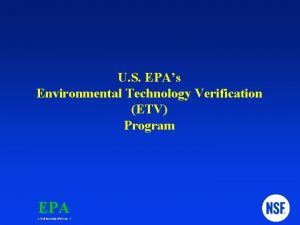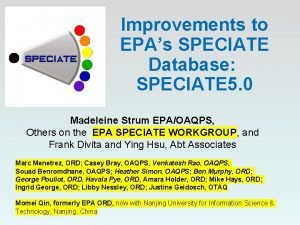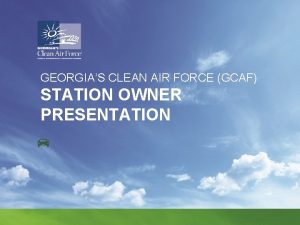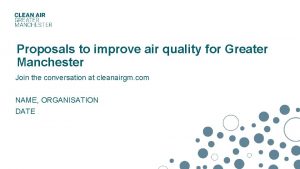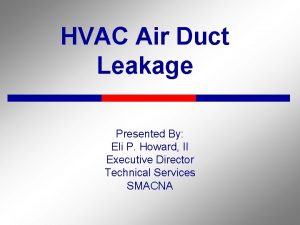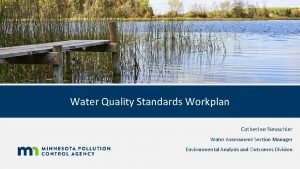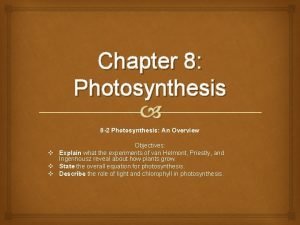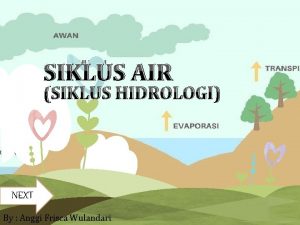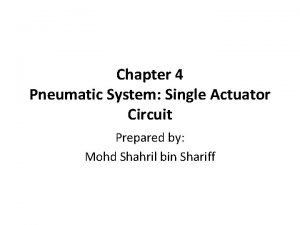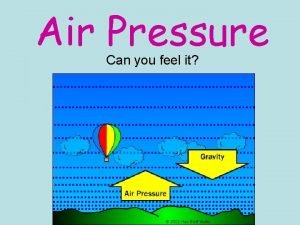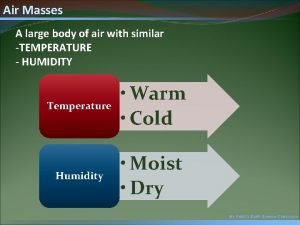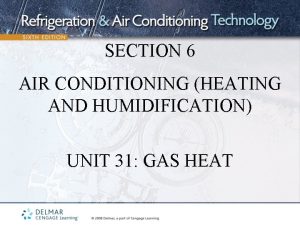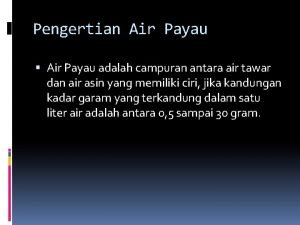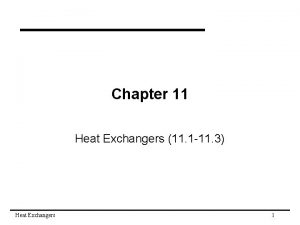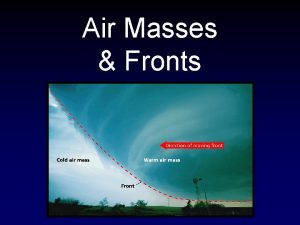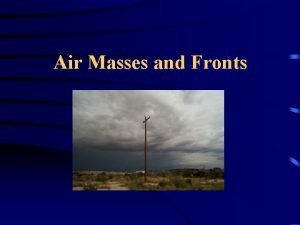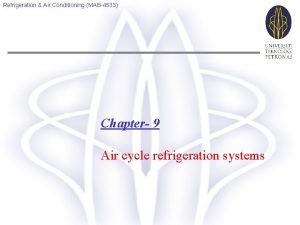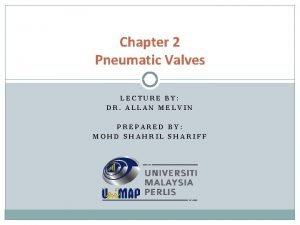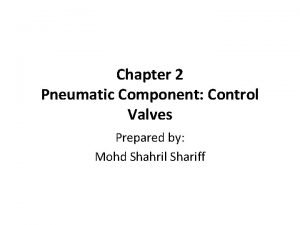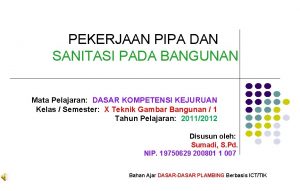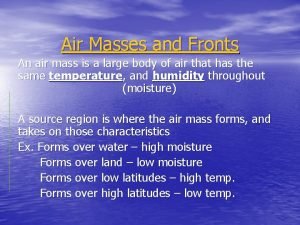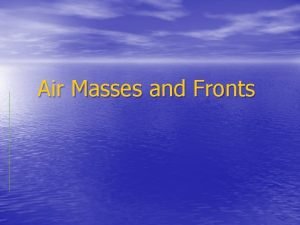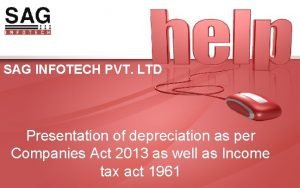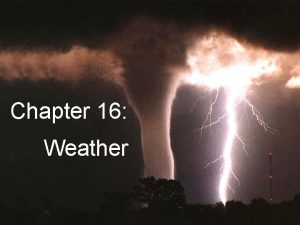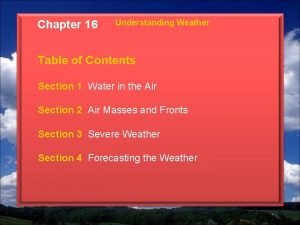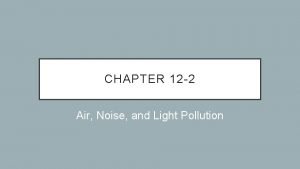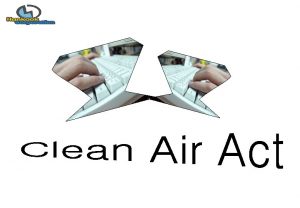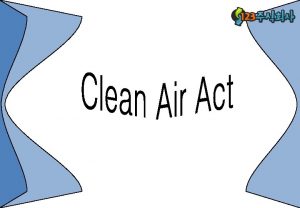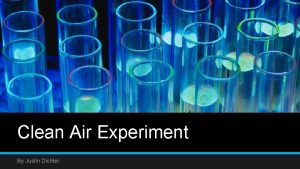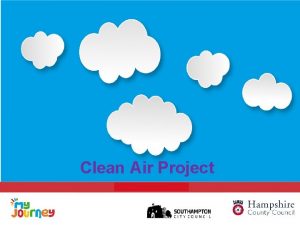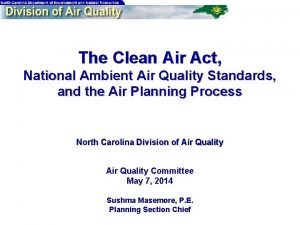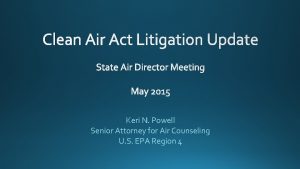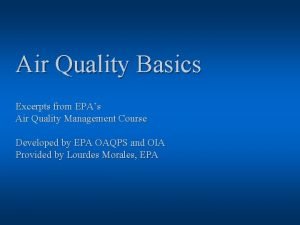Overview of EPAs Final Clean Air Act Section














































- Slides: 46

Overview of EPA’s Final Clean Air Act Section 111(d) Emissions Guidelines for Greenhouse Gas Emissions from Existing Electric Generating Units Air Quality Committee Special Information Session September 9, 2015 Sushma Masemore, PE Planning Section Chief Division of Air Quality Department of Environment and Natural Resources

Topics Covered North Carolina’s Historical Emissions Authority Approach Interim and Final Goals Timeline State Plan Components Emissions Trading Reliability Assurance Community Involvement 2

Key Terms Carbon Dioxide (CO 2) mass emissions = ton of CO 2 emitted from Electric Generating Units (EGUs) Net Electric Output = gross electric generation minus electricity used to operate plant equipment and includes transformer losses at the point of sale CO 2 Rate = CO 2 mass emissions ÷ Net Electric Output Heat Rate = energy input to the boiler ÷ Net Electric Output Heat Rate Improvement = any measures taken inside the footprint of the EGU facility to decrease the heat rate of the affected unit § Equipment repairs, modifications, replacements, or upgrades § Changes to processes or control systems § Changes to management practices such as maintenance procedures and load management § Utilization of thermal energy produced from combined heat and power system § Others 3

Key Terms NGCC = natural gas combined cycle power plants RE = renewable energy generation from zero to no carbon emitting sources such as solar and wind EE = energy efficiency achieved through actions by end-users such as lighting improvements and the use of more efficient appliances BSER = Best System of Emissions Reductions available to an affected source to achieve emissions reductions after considering cost, technical feasibility, useful life, etc. 4

Historical Trends in NC’s CO 2 Rate and Emissions CO 2 Rate Fossil Fuel CO 2 Rate (lb/MWh) 2 500 2 000 1 500 1 000 Reductions Already Achieved: 500 - Fossil Fuel CO 2 Emissions (1000 metric tons) 2002 2003 2004 2005 2006 2007 2008 2009 2010 2011 2012 2013 CO 2 Mass Relative to 2005 Rate: 18. 8% Mass: 25. 8% Relative to 2012 Rate: 7. 8% Mass: 1. 6% 90 000 80 000 70 000 60 000 50 000 40 000 30 000 20 000 10 000 2002 2003 2004 2005 2006 2007 2008 2009 2010 2011 2012 2013 Source: Energy Information Administration 5

CLEAN POWER PLAN: AUTHORITY 6

Authority Cited in EPA’s Clean Power Plan Clean Air Act section 111(d) 40 Code of Federal Regulations (CFR) Part 60 Applies to fossil fuel-fired electric generating units (EGUs) that began construction on or before January 8, 2014 Signed August 3, 2015 http: //www 2. epa. gov/cleanpowerplan/clean-power-plan-existing-power-plants Requires reductions in CO 2 rate or mass emissions by 2030 relative to 2012 levels EPA applied BSER (considering cost, size of reductions, technology, feasibility) to develop guidelines for states to achieve 7

Affected Sources in North Carolina 8

Rule Content and Supporting Documents Final Rule (1, 560 pgs) Regulatory Impact Analysis (343 pgs) Technical Documents § Power Sector Modeling (322 pgs + many spreadsheets) § Legal Memorandum for Certain Issues (152 pgs) § Emission Performance Rate and Goal Computation (50 pgs + spreadsheet) § New Source Compliments to Mass Goals (10 pgs + spreadsheet) § GHG Mitigation measures (274 pgs + spreadsheet) § Resource Adequacy and Reliability Analysis (57 pgs) § Incorporating Renewable Energy and Energy Efficiency into State Plans (20 pgs) § Demand-Side Energy Efficiency (105 pgs + spreadsheets) Fact sheets 9

CLEAN POWER PLAN: EPA’S APPROACH 10

Determination of Best System of Emissions Reductions (BSER) System = network of electrical grid connecting power sources BSER based on three building blocks BSER applied to three interconnections to create: 1 Uniform emission performance rate for: Fossil Steam (Coal + Oil) units Natural gas combined cycle (NGCC) units 2 State rate goal 3 State mass goal 11

Goal Setting Method 2012 Baseline Emissions for Each State (coal, oil, NGCC) Under construction units added Adjusted 2012 Baseline Emissions for Each State (coal, oil, NGCC) Regional 2012 Baseline Emission Rate (fossil steam, NGCC) Building Block 1 Heat Rate Improvement 3 State Mass Goal Excess Building Block generation not needed to meet performance rate goal (aggregate) Building Block 3 Renewable Energy shifts fossil steam and NGCC Building Block 2 2 State Rate Goal (aggregate) 1 Regional Rates Emission Performance Rates (fossil steam, NGCC) Least stringent regional rate used For Three Interconnection s 75% NGCC capacity further shifts fossil steam (fossil steam, NGCC) 12

State NC WV MA MO OH DE PA TX MD SC KY IN NE NY SD TN IA MI AL FL AR GA LA IL OK MN WI KS ND NH VA NJ MS MT CT Coal Steam 2012 CO 2 Emission Rate (lb/MWh) 2, 054 2, 064 2, 070 2, 083 2, 124 2, 128 2, 133 2, 160 2, 161 2, 163 2, 166 2, 168 2, 181 2, 226 2, 240 2, 244 2, 250 2, 256 2, 263 2, 279 2, 287 2, 294 2, 297 2, 301 2, 309 2, 332 2, 363 2, 365 2, 368 2, 382 2, 419 2, 441 2, 494 2, 633 3, 027 2012 Baseline CO 2 Rates NC’s Coal Plants had the lowest CO 2 Emission Rate in 2012 Regional Fossil Steam Rate range 2012 Regional NGCC Rate range State TN CT GA MS WI ME SC NC OH FL AL MN NH LA MA MO IA OK AR NM PA VA RI IL NJ IN NY MD DE MI NE TX NGCC 2012 CO 2 Emission Rate (lb/MWh) 771 811 840 844 846 848 853 866 867 877 878 881 889 890 891 895 896 897 902 909 918 945 949 953 975 979 998 1, 016 1, 056 13

Summary of North Carolina’s Interim and Final Targets 1 Uniform Emission Performance Rate (lb/MWh) NC’s 2012 Baseline Rate 2 Final Performance Rate: 2030 Fossil Steam 2, 054 1, 534 1, 305 NGCC 853 832 771 North Carolina Rate Goal (lb/MWh) NC’s 2012 Baseline Rate NC Aggregate 3 Interim Performance Rate: 2022 -2029 Interim Rate Goal: 2022 -2029 1, 778 1, 311 Final Rate Goal: 2030 1, 136 North Carolina Mass Goal (annual tons) NC’s 2012 Baseline Emissions NC Aggregate 58, 353, 477 Interim Mass Goal: 2022 -2029 56, 986, 025 Final Mass Goal: 2030 51, 266, 234 14

BUILDING BLOCKS 15

Building Block 1: Heat Rate Improvements at Affected Coal Units Regionally derived heat improvement used to reduce CO 2 emissions from affected coal-fired EGUs in each interconnection region § Eastern = 4. 3% § Western = 2. 1% § Texas = 2. 3% Goals cannot be met solely through heat rate improvement 16

Building Block 3: Renewable Energy (RE) Applied before Building Block 2 RE = onshore wind, solar (utility scale/concentrated, geothermal, hydroelectric) Existing RE not counted, only the incremental amount RE Generation Potential calculated based on economic modeling of each interconnection region § Excess RE from Western and Texas interconnections calculated using a model. Accounts for portion not needed to meet less stringent performance rates in the Eastern interconnection. RE Generation replaces 64% of coal generation and 36% of NGCC generation in the Eastern Interconnection 17

Building Block 2: NGCC Capacity Increased to 75% Used as a ceiling to further reduce fossil steam generation NGCC generation at 75% capacity factor reduces additional fossil steam generation beyond those already replaced through renewable energy in Building Block 3 States can specify their own glide paths to achieve 75% NGCC capacity by 2030 18

Other BSER Options Outlined in EPA’s Guidelines Demand side energy efficiency New or uprated nuclear generation Other types of renewables (distributed solar, offshore wind) Sustainable biomass Combined heat & power, waste heat power Transmissions and distribution improvements Inclusion of new NGCC for mass-based goal 19

COMPLIANCE TIMELINE UNDER EPA’S CLEAN POWER PLAN 20

Key Dates Under EPA’s Clean Power Plan Sept. 6, 2016 – Final Plan or Initial Submittal (with request for extension) § Sept. 6, 2017 – Initial Submittal update due if extension granted § Sept. 6, 2018 – Final Plan due if extension granted July 1, 2021 – Milestone status report due 2022 -2029: Interim goal to be achieved § July 1, 2025: meet Interim Step 1 Goal for 2022 -2024 § July 1, 2028: meet Interim Step 2 Goal for 2025 -2027 § July 1, 2030: meet Interim Step 3 Goal for 2028 -2029 2030: Final goal to be achieved § July 1, 2032 and every 2 years beyond 21

STATE PLAN COMPONENTS 22

Initial Plan Components (If Final Plan is not submitted by Sept. 6, 2016) Explanation why the state requires additional time 2. Final Plan approach under consideration, including progress made to date 3. Demonstration of public engagement (including vulnerable communities) 4. If interested, non-binding statement of interest in the Clean Energy Incentive Program (CEIP) 1. 23

Types of Final State Plans Must define whether the state will achieve § Federal emission performance rates or § State rate-based goal or § State mass-based goal Choose between 2 types of Plans § Emissions Standards Plan § State Measures Plan 24

Emissions Standards Plan & State Measures Plan Emissions Standards Plan • • Performance Rate State Rate-Based State Measures Plan • Mass-Based Regulates only the owners/operators of covered EGUs must meet their required performance rate or statespecific rate-based goal Similar to other Clean Air Act programs Consists of federally enforceable or combination of federally enforceable and state only enforceable requirements Must result in EGUs meeting the EPA’s or state’s massbased goal Must be “quantifiable, verifiable, enforceable, nonduplicative and permanent” States can impose requirements on non-EGUs through state law § Examples: renewable energy, energy efficiency § Not federally enforceable If state measures don’t perform as planned, federally 25

Final Plan Components Federally Enforceable (Codified) 40 CFR 60. 5740 Sections 1 -5 + Non-Enforceable (Not Codified) 40 CFR 60. 5745 Paragraphs (a)1 -13 26

OTHER COMPONENTS EMISSIONS TRADING RELIABILITY ASSURANCE COMMUNITY INVOLVEMENT 27

Key Summary Points States must choose their approach: § Federal emission performance rates or § State rate-based goal or § State mass-based goal States must submit a Final Plan by Sept 6. , 2016 or Sept. 6, 2018 (if extension is granted) Final Plan must contain federally enforceable and stateonly enforceable measures § Demonstration of compliance for each component must in be great detail to ensure interim and final goals will be met 28

Visual Depiction of North Carolina’s Targets CO 2 Rate (lb/MWh) 1 Emission Performance Rates 2 000 1 500 Fossil Steam 1 000 NGCC 500 0 NC 2012 NC 2014 Actual State Aggregate CO 2 Rate (lb/MWh) 2 000 1 800 1 600 1 400 1 200 1 000 800 600 400 200 0 NC 2012 Actual NC 2014 Actual Interim Final Goal 20222030 2029 NC Mass Goal 3 State Aggregate CO 2 Emissions (million tons) NC Rate Goal 2 Interim Final 2030 2022 -2029 62 60 58 56 54 52 50 48 46 NC 2012 Actual NC 2014 Actual Interim Goal Final Goal 2022 -2029 2030 29

Questions? Contact Sushma Masemore, PE Division of Air Quality 919 -707 -8700 sushma. masemore@ncdenr. gov 30

ADDITIONAL REFERENCE MATERIALS FROM EPA’S CLEAN POWER PLAN 31

1 Emission Performance Rates FOSSIL STEAM Region 2012 Regional Fossil Steam Rate (lb/MWh) Final 2030 Fossil Steam Performance Rate (lb/MWh) 2030 Regional Fossil Steam Rate (lb/MWh) Eastern 2, 160 1, 305 (least stringent) Western 2, 198 360 Texas 2, 192 237 1, 305 NGCC Region 2012 Regional NGCC Rate (lb/MWh) Final 2030 NGCC Performance Rate (lb/MWh) 2030 Regional NGCC Rate (lb/MWh) Eastern 894 771 (least stringent) Western 899 690 Texas 951 697 771 32

2 North Carolina’s Rate Goal % State’s Generation from Fossil Steam & NGCC in 2012 Performance Rate x = State Rate Goal North Carolina 2012 NC Rate (lb/MWh) Fossil Steam NGCC NC Aggregate 2012 NC Generation by Source Type Final 2030 Performance Rate (lb/MWh) 2, 054 68% 1, 305 853 32% 771 1, 778 Final 2030 NC Rate Goal (lb/MWh) 1, 136 33

Rate Goal Comparisons with Other States Final 2030 State Rate Goals 1, 136 CO 2 Rate (lb/MWh) 1 400 Fossil Steam Goal 1 200 1 000 800 NGCC Goal 600 400 200 ID RI ME CT NJ MA CA NV NH OR DE NY FL VA MS WA AL AZ TX GA OK PA LA AR NC NM SC SD MI CO WI UT OH TN MN IN IL MO IA KY MD KS NE WY MT ND WV - % Reduction in State Relative to 2012 Baseline 60% 36% 50% 40% 30% 20% 10% ID CT NM ME MS RI MA CA NY OR NH FL NJ NV LA DE OK PA AL AZ VA SC NC TX MO AR MD UT WV IN OH GA NE MI KY WA MN SD IA WI CO TN KS WY IL ND MT 0% Note: Goals and % reductions are highly dependent on each State’s unique generation mix. 34

3 State Mass Goal Method State Rate Goal x 2012 State Generation + 2 X NC Excess RE = State Mass Goal Excess RE Potential from Western & Texas Interconnections developed using optimization algorithm § Excess RE is the portion not needed to meet the less stringent performance rates in Eastern interconnection Apportion Excess RE Potential based on 2012 share of affected EGU generation § NC = 3% New Source Compliment (not addressed today) – allows new sources subject to 111(b) standards to be moved under 111(d) 35

3 North Carolina’s Mass Goal North Carolina NC’s 2012 Baseline Mass Emissions (annual tons CO 2) NC Aggregate 58, 353, 477 Final 2030 North Carolina’s Mass Goal (annual tons CO 2) 51, 266, 234 Note 1: EPA’s 2015 Power Sector Modeling projects that NC’s CO 2 emissions without the CPP will be 48, 856, 544 tons in 2020. Note 2: The 2014 Power Sector Modeling projected much higher emissions at 64, 658, 776 tons CO 2 for 2020. 36

Mass Goal Comparisons with Other States 200 180 160 140 120 100 80 60 40 20 - 51 ID ME RI SD NH DE CT OR WA MT MA NM NV MD NJ NE ND KS MN UT IA MS SC VA WI TN CO AZ AR NY WY LA OK GA MI CA NC WV MO AL KY IL OH IN PA FL TX CO 2 Mass Emissions (million tons) Final 2030 State Mass Goal % Reduction in State Mass Relative to 2012 Baseline 50% 40% 12% 30% 20% 10% -10% WA ME SD NJ CA OR VA CT MS DE RI MA NY FL NC NV NH LA MN TX GA UT PA OK AR AL AZ OH IL SC CO NM TN MD MO WV IN KY MI NE WI IA KS WY MT ND 0% -20% Note: Goals and % reductions are highly dependent on each State’s unique generation mix. 37

Federally Enforceable Components in the Final Plan Component 1 - Identify affected EGUs and their CO 2 emissions Component 2 – Required for emission rate based goals Identify all emission standards Compliance periods for each emission standard Demonstrate how CO 2 emission performance rate or rate goal will be achieved Corrective measures § Multiple triggers at interim steps Component 3 – Required for mass-based goals only Federally enforceable backstop - emission standards for affected EGUs during interim & final periods Triggers for backstop 38

Federally Enforceable Components in the Final Plan (Cont’d) Component 4 - Required for all goal plans Monitoring, reporting and recordkeeping for each affected EGU Component 5 – Required for all goal plans Process, contents and schedule for state reporting Report to EPA by July 1, 2021 that NC is on track to meet milestones defined in State Plan 39

Non-Federally Enforceable Components in the Final Plan Component 1 – Define State Plan approach and geographic scope Component 2 – Identify emission performance rates or state rate goal or state mass goal for interim period, interim steps, and final period Component 3 – Demonstrate that affected EGUs are projected to achieve CO 2 goals Component 4 – Demonstrate that affected EGU’s emission standard is quantifiable, non-duplicative, permanent, verifiable and enforceable 40

Non-Federally Enforceable Components in the Final Plan (Cont’d) Component 5 – Demonstrate achievement of rate-based or mass-based goals Component 6 –State Measures Information § Descriptions of all state measures, including applicable state laws or regulations § Projected impacts § Parties implementing State Measures § Schedule and milestones § CO 2 performance projection Component 7 – Demonstrate that reliability of the electrical grid has been considered 41

Non-Federally Enforceable Components in the Final Plan (Cont’d) Component 8 – timeline of all milestone steps Component 9 – demonstrate state’s legal authority and funding to implement and enforce each component Component 10 – demonstrate each interim step goal will be met, include analytic process, tools, methods and assumptions Component 11 – certification that a public hearing of the State Plan was held Component 12 – documentation of community outreach and involvement 42

Emissions Trading Market based policy that creates financial incentive to reduce emissions where the costs of doing so are the lowest States can design “trading ready” rate-based or massbased plans Allows EGUs to use creditable out-of-state reductions to achieve required CO 2 reductions EGUs meet their emission standards via emission rate credits – ERCs (for a rate-based standard) or allowances (for a mass-based standard) 43

Reliability Safety Valve EPA’s approach to avoid threats to grid reliability during implementation State must demonstrate that it has considered reliability issues in developing its State Plan Safety valve triggered on EGU when there is conflict between requirements of the State Plan and maintenance of electric system reliability due to unforeseen or catastrophic events § Source emissions will be excluded from applicable emissions standards for 90 days § During the 90 -day period, the source must meet an alternative emission standard that will not jeopardize grid reliability 44

Clean Energy Incentive Program Optional for states Early credit program for RE and EE programs started in 2020 and/or 2021 § Credits may be banked or traded RE § Must generate electricity from wind or solar sources § For every 2 MWh generated, project receives 1 credit EE § Must implement in low-income communities § Electricity savings must be quantified and verified § For every 2 MWh saved, project receives 2 credits 45

Community Involvement & Environmental Justice Plans must demonstrate engagement with communities as part of public participation process in formulating state plans Assessment of localized and community impacts 46
 Epa medical education
Epa medical education Enabler social work
Enabler social work Epas technologies
Epas technologies Radviliada istorinis kontekstas
Radviliada istorinis kontekstas Epas database
Epas database Clean air act of 1990
Clean air act of 1990 Clean air act philippines
Clean air act philippines Clean up everybody let's clean up
Clean up everybody let's clean up Air higroskopis air kapiler dan air gravitasi
Air higroskopis air kapiler dan air gravitasi Section 1: what causes air pollution answer key
Section 1: what causes air pollution answer key Chapter 12 air section 1 what causes air pollution
Chapter 12 air section 1 what causes air pollution Gcaf north
Gcaf north Manchester clean air zone
Manchester clean air zone Eli p llc clean air
Eli p llc clean air Macbeth act 2 summary
Macbeth act 2 summary Clean water act
Clean water act Clean neighbourhoods and environment act 2005 dog fouling
Clean neighbourhoods and environment act 2005 dog fouling Section 8-2 photosynthesis an overview
Section 8-2 photosynthesis an overview Air di bumi selalu tersedia lantaran adanya …
Air di bumi selalu tersedia lantaran adanya … Air termasuk pelarut organik atau anorganik
Air termasuk pelarut organik atau anorganik Indirect control of single acting cylinder
Indirect control of single acting cylinder Can you feel it in the air in the air
Can you feel it in the air in the air A large body of air
A large body of air Two cold air masses converge on a warm air mass
Two cold air masses converge on a warm air mass You put your left hand in
You put your left hand in All kinds of shapes
All kinds of shapes Return air and supply air
Return air and supply air Right hand in the air left hand in the air
Right hand in the air left hand in the air Pengertian air payau adalah
Pengertian air payau adalah Dtlm heat exchanger
Dtlm heat exchanger Air masses & frontswhat is an air mass?
Air masses & frontswhat is an air mass? Air masses & frontswhat is an air mass?
Air masses & frontswhat is an air mass? Air cycle cooling system
Air cycle cooling system Flow control valve direction
Flow control valve direction Shuttle valve symbol
Shuttle valve symbol The boundary between two adjacent air masses is called
The boundary between two adjacent air masses is called Air temperature
Air temperature Yang termasuk kelompok pekerjaan sanitasi adalah
Yang termasuk kelompok pekerjaan sanitasi adalah A swirling center of low air pressure is called
A swirling center of low air pressure is called Cold air mass overtakes warm air mass
Cold air mass overtakes warm air mass Air masses & frontswhat is an air mass?
Air masses & frontswhat is an air mass? Air masses & frontswhat is an air mass?
Air masses & frontswhat is an air mass? Air masses & frontswhat is an air mass?
Air masses & frontswhat is an air mass? Akubation
Akubation Chapter 16 section 1 water in the air answer key
Chapter 16 section 1 water in the air answer key Chapter 16 section 1 water in the air answer key
Chapter 16 section 1 water in the air answer key Section 2 air noise and light pollution
Section 2 air noise and light pollution


